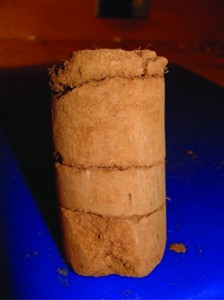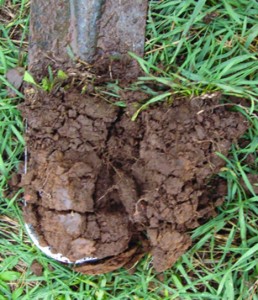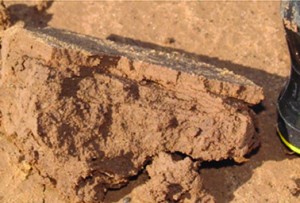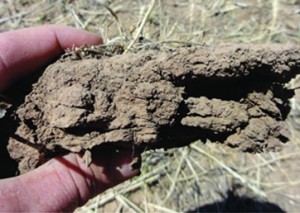Managing Soil Compaction
- Jump To:
- Introduction
- Forms of Compaction
- Summary
Introduction
Soil compaction due to large modern equipment and grazing can be a concern for Oklahoma cropland soils. This Fact Sheet will discuss characteristics influencing a soil’s susceptibility to compaction, management practices to minimize compaction and options to remedy compaction.
Soil Characteristics
To understand compaction, it must first be understood that soils are made of mineral particles, organic matter and pore space. The mineral fraction of a soil consists of sand, silt and clay size particles. These particles do not generally fit tightly together in their natural state. There are pore spaces between these particles and aggregates, which are important for air and water movement, root growth and water storage in the soil system. Large pores (macropores) are important for air movement, root growth and water infiltration. Small pores (micropores) are important for water-holding capacity. Compaction is the process of the particles moving closer together such that the total volume they occupy is decreased and the pore volume is decreased. Especially, the number and size of macropores are decreased, thereby decreasing air movement, root growth and water infiltration.
Soil moisture is critically important to the process of compaction. Dry soils are difficult to compact because the friction between particles prevents them from moving. On the other hand, very wet soils are difficult to compact because pores are filled with water, which must be squeezed out before compaction can occur. Equipment may create ruts when soils are saturated because the saturated soil is moving around them. This does not necessarily result in compaction because the duration of the pressure is not long enough to allow the water to flow out of the pores to allow the particles to compress together. In contrast, ruts or depressions formed in moist soil do indicate compaction has occurred. Moist soils are the most susceptible to compaction because there is sufficient moisture to allow particles to move and the macropores, which are most susceptible to compaction, are not filled with water to keep them from compressing.
Texture (the percentage of sand, silt and clay) is important in determining a soil’s susceptibility to compaction. Clayey soils are difficult to compact because at moisture contents sufficient to allow the clay particles to move past each other, the pore space is typically filled with water, which cannot be squeezed out easily. Sands are also difficult to compress because the relatively large sized particle are difficult to compress. Also, sandy soils generally have little or no structure regardless of compaction, therefore the particles settle into position with very little mechanical force applied (this characteristic is why sand is used as a base for concrete slabs and other construction projects). Moderately textured soils (e.g. loam, silt loam, sandy loam) are the most easily compressed. Sandy loams are the most susceptible to compaction because they generally have some structure, which provides macropores in the soil system, but the structure is very weak. The term ‘weak’ means that the cohesive forces holding the particle together can be easily overcome and the particles can move into the macropores.
Some chemical characteristics of soil can play a role in compaction, or at least the density of soils. Specifically, soils containing high levels of sodium can become very dense because the sodium prevents clay particles from adhering to each other, therefore they easily move past each other and become compacted. In sodic soils, particles become completely dispersed (having no structure) and very dense. Information on the identification and remediation of sodic soils can be found in Extension Fact Sheet PSS-2226.
Soil structure is a term used to describe the arrangement of soil particles. Highly structured soils will have more and larger macropores. Soils with high amounts of organic matter generally have better structure and are more resistant to compaction. However, organic matter lost as a result of historic tillage has left most cropland soils more susceptible to compaction. No-till management can allow organic matter levels to increase. Efforts to minimize soil compaction must be made when establishing a no-till system.
The natural density and resistance to penetration of soil generally increases with depth. Soils contain multiple layers, which may differ in soil structure, texture, color or chemical composition. This is important when evaluating soil compaction, particularly when a push probe or penetrometer is used to find compacted layers. Natural variation in the resistance to penetration among layers may incorrectly be interpreted as compacted layers needing alleviation.
A soil’s capacity to shrink and swell upon drying and wetting is important when considering soil compaction. In general, soils containing 30 percent or more clay will dramatically expand and contract during wetting and drying cycles. First, these soils are less susceptible to compaction because of their high clay content. Secondly, the expansion and contraction of these soils can naturally alleviate compaction; therefore they seldom respond to tillage remedies.
Forms of Compaction
Crusts
Soil crust formation involves the processes of dispersion, segregation and drying. The soil is dispersed by the impact of raindrops on the surface. This dispersion is followed by segregation, where clay particles are removed, leaving silt and sand particles at the surface. This causes the soil particles at the surface to be very closely packed and to have a high bulk density. The strength of this crust is then increased upon drying. Crust formation is most detrimental to crop growth in soils with high silt content because the crust can be very dense and does not crack upon drying. Crusts can vary in thickness from less than a ¼-inch to several inches. These layers restrict water movement, oxygen diffusion and seedling emergence. The crusts can also affect water and wind erosion and reduce surface water infiltration.
Tillage Pans
Tillage pans, most commonly called plow pans, are caused by shearing the soil. As the soil is sheared, the soil particles align to create a smeared layer. Continual tillage at the same depth creates a layer of aligned soil particles denser than the soil above and below it. Tillage pans are common in many cultivated soils, but they are not always restrictive to root growth. Alternating tillage depths can minimize the formation of restrictive plow pans.
Traffic Induced Compaction
Soil compaction from equipment is generally divided into two zones. The shallow zone is approximately the top 6 inches to 10 inches, or the normal tillage zone. Compaction in this shallow area is related to the pressure applied to the soil. For vehicles with tires, ground pressure mostly depends on tire inflation pressure. A higher inflation pressure will cause more ground pressure, and thus greater shallow compaction than a lower inflation pressure. Some tire configurations allow lower inflation pressures on equipment. Dual tires can operate at lower inflation pressures than similar sized single tires because the weight is spread over more contacting area. Larger tires can support the same weight as smaller tires with a lower inflation pressure. Radial tires have a larger footprint than the same size bias ply tire. This means they will have lower ground pressure. Rubber belted tracks also have a larger footprint and cause less shallow compaction.
Tire inflation pressure should be set to support the load the tires support. It is based on the axle load, number of tires and tire size. The only way to determine the correct inflation pressure is to use a load-inflation table. These are typically available from tire or equipment dealers.
Deeper compaction or compaction below 10 inches is related to the force applied to
the soil. This force is determined by axle loads on vehicles. Greater axle loads lead
to deeper compaction. Larger tractors weigh more and are more likely to cause deeper
compaction. Combines and grain carts have higher axle loads than most tractors, having
the potential to cause more compaction in the deep zone.
Managing vehicle traffic is one method to reduce equipment induced soil compaction.
Fewer trips across a field with a tractor mean less of the field is exposed to tire
traffic and compaction. While restricting tractor traffic when soils are wet is feasible,
combines need to operate when the crop is ready for harvest. However, managing grain
cart traffic can help manage compaction. If conditions are wet, consider keeping the
grain cart at the edge of the field. Also, if crop yield is low enough that it doesn’t
warrant unloading on the go, consider leaving the grain cart at the edge of the field.
Compaction from Grazing
Grazing is an important component of cropland systems in Oklahoma. Compaction from grazing can be detrimental to crop production if not managed properly. The first thing to know is that compaction from grazing is isolated in the top 4 inches to 6 inches of soil. Therefore, in cultivated systems, normal tillage practices will remove the effects of grazing induced compaction. No-till systems require more careful consideration. First, grazing should be limited to periods when surface soils are dry. Dual purpose wheat grazing generally lends itself to this because cattle are placed on wheat pasture in late November to early December, then removed in late February to early March. On average, this period for grazing represents the driest months in Oklahoma. Overgrazing should be avoided during this period for a variety of reasons, but especially for the prevention of compaction. Overgrazing reduces crop vigor and root growth, which is critical in preventing compaction.
The practice of graze-out in a no-till system is much more concerning than dual purpose management, because it extends grazing into the wetter spring months. Graze-out can also result in the near complete removal of surface residues, which can be very damaging to the soil surface. Figure 1 shows surface compaction in a soil collected in late July after grazing left the surface bare. Here, grazing resulted in a highly compacted condition. Additionally, the removal of residue allowed for crusting and further prevented water infiltration. This is a perfect example of the extent to which surface soils can be damaged through overgrazing. Grazing at levels that maintain surface residue, or removing cattle to allow regrowth, will generally prevent this condition from occurring. If regrowth is limited, planting a cover crop is recommended to regain surface residues. Figure 2 shows a soil with excellent granular and blocky structure near the soil surface, despite being grazed annually for more than15 years. This is an example of how grazing cropland can coincide with good soil health when thoughtful residue management and stocking rates are utilized. However, if the damage is so severe that a cover crop cannot be established, tillage is the only option in reclaiming productivity. Deep tillage is not required to remedy this damage. Despite the severity of this type of damage, compaction from grazing is only observed to depths of 4 inches to 6 inches, therefore normal tillage operations can be used to remove this compaction.
Figure 1. An excessively compacted soil core (4 inches) collected in July from a grazeout wheat pasture.
Identification of Compaction
There are a variety of methods and tools that can be used to evaluate soil compaction. A penetrometer is a pointed steel rod with a gauge recording the pressure needed to penetrate the soil. It provides a specific reading, but must be carefully interpreted. Measures of penetration resistance are highly dependent on soil moisture and the speed it is pushed into the soil. A dry soil will have greater resistance than a soil at field capacity. Therefore, caution should be exercised when using a penetrometer— it should only be done when the soil profile is moist. Pushing the penetrometer into the soil faster will give a higher reading. A simple push rod can give a relative assessment of soil compaction, but its use also is very much dependent on soil moisture.
Figure 2. Granular and blocky structure near the surface of a silt loam grazed-out under no-till management
The best tool for identifying compaction is a shovel. A push rod or penetrometer is useful for quick assessment, but only visual observations can confirm the presence of a compacted layer. Soil crusts (Figure 3) are easy to identify as dense layers on the soil surface. Other forms of compaction will require digging to a depth below the suspected compaction. A plow pan can be identified as horizontal structure directly below the tillage layer. Grazing induced compaction (Figure 4) can also be identified as horizontal structure in the top 6 inches of soil.
Figure 3. Surface crust on a silt loam soil.
Where horizontal structure is not observed, pressing a knife into an undisturbed side of the hole every inch to two inches, starting at the top, can be used to identify dense layers. If this corresponds to an abrupt decrease in root growth or horizontal root growth, compaction may be the cause. Horizontal root growth or an abrupt decrease in root growth also can be caused by a lack of soil moisture at or below this depth. It is always best to evaluate compaction after a period of rainfall sufficient to saturate the profile and when evapotranspiration is low. It is ideal to evaluate compaction in the early spring in Oklahoma when soil moisture contents are generally the greatest. If dry soil is found below a suspected compacted layer after a period of rainfall, it is likely that some form of compaction is limiting water infiltration.
Figure 4. Horizontal structure just below the surface in a grazed wheat field.
Prevention
Surface residues can prevent the formation of crusts, but provide limited value in preventing traffic-induced compaction. Extensive root systems are much more effective at preventing traffic compaction because they serve as a skeleton for the topsoil. Live roots are more effective than dead, brittle roots.
The best prevention for compaction is to avoidance. This can be achieved by limiting
traffic during periods when soils are wet. If this is difficult to implement, tire
size and inflation pressures must be considered to distribute weight to minimize compaction.
However, this can only minimize surface compaction and does not prevent deep compaction.
Deep compaction may be isolated to small areas of the field through the practice of
controlled traffic. Remember, even if isolation all of your field activities to controlled
traffic lanes cannot be done, efforts to create traffic lanes for very heavy equipment
such as grain carts and combines, or for activities requiring multiple passes such
as spraying, will reduce overall compaction in the field. It also will isolate compaction
locations that can be monitored over time, and treated when mechanical means of removing
compaction are needed.
Compaction Remediation
After compaction has been identified, the next step is to determine remediation options.
The options are dependent on the depth of the compaction, tillage system and soil
type.
If compaction is less than 10 inches deep, a chisel plow can be used to break up the
compacted layer. If compaction is observed below this depth, deep tillage may be required.
There are a variety of options for deep tillage equipment, including parabolic rippers,
disk rippers for conventionally tilled systems and paraplows or straight shank rippers
designed for low surface disturbance. No studies are available in the central plains
to evaluate differences in crop response between the various deep tillage options.
Research at OSU suggests few Oklahoma soils have compaction zones deep enough and
with high enough bulk densities to warrant deep tillage. Additionally, the body of
research evaluating yield response of compacted soils to deep tillage is inconclusive,
suggesting that specific conditions must be met before the crop following deep tillage
will respond with increased yields. First, deep tillage should be conducted when the
compacted zone is dry. Secondly, sufficient rainfall must be experienced after deep
tillage to recharge the profile. In contrast, deep tillage will increase the depth
to which soils will become dry, if drying conditions are experienced. This can result
in decreased yields after deep tillage.
In conservation systems, there must be sufficient time after deep tillage to allow
the soil to settle to provide a uniform seed bed. Also, deep tillage of clay loam
soils with conservation tillage can be problematic. Specifically, when these soils
are dry enough to shatter deep tillage, it can result in clods being pulled to the
surface, requiring secondary tillage to smooth the surface. Fortunately, clay loam
soils are not prone to compaction and do not respond to deep tillage, therefore it
is not recommended deep tillage be performed on them.
In general, temperatures are not low enough in Oklahoma for freeze/thaw action to
remediate compaction. However, shrink/swell can be effective at remediating shallow,
as well as deep compaction. Soils must go through wetting and drying cycles for this
to occur; therefore relying on this natural occurrence is not feasible every year.
This action is most prevalent in clay loam soils and does not occur in sandy loams.
Recently, utilization of cover crops to remedy or prevent compaction has received a lot of interest. Cover crops are meant to prevent compaction by increasing soil organic matter, root growth and surface residues. Organic matter increases aggregate stability, which reduces the soil’s susceptibility to compaction. Root growth of the cover crops may remediate compaction if it is sufficient to penetrate compacted layers. However, despite research showing increased root growth after cover crop treatments, it has not shown consistent yield improvements following soil conditioning cover crops. Therefore, it is recommended that cover crop strips be planted across a field suspect of being compacted to observe the response of the following crop. Similarly, deep tillage strips are also recommended to determine if it is beneficial. In both cases, it will take multiple years to properly assess the yield benefits of these compaction alleviation practices. Both soil type and weather conditions influence their effectiveness in improving yield of the following crop.
Summary
Some level of compaction is apparent in much of Oklahoma’s cropland. However, impact on crop productivity is dependent of its severity, soil type, crop type and the weather. The best cure for compaction is prevention. Utilize proper tire sizes and inflation pressures, or consider tracks to prevent surface compaction, which is most detrimental in no-till systems due to its impact on crop establishment. Minimize the traffic of heavy loads across the field, especially in moist soil conditions to prevent deep compaction. Lastly, avoid overgrazing cropland under no-till management, which can cause severe compaction in the near surface soil.




